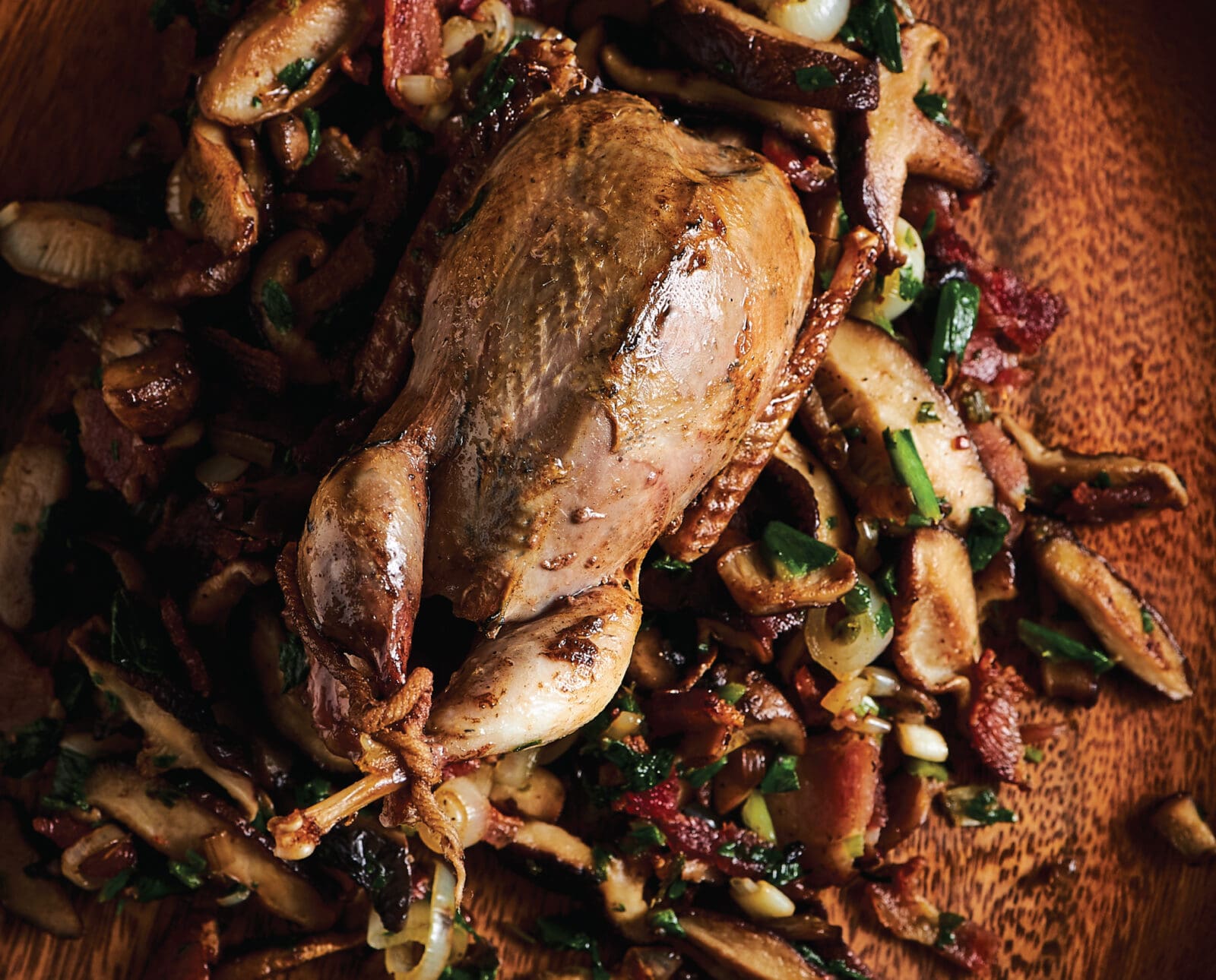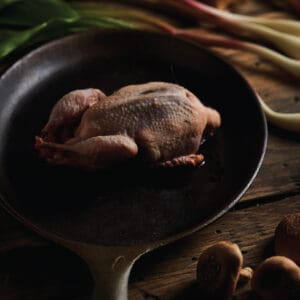Home » Small Game Cooking » Mastering the Art of Roasting Woodcock Perfectly
Mastering the Art of Roasting Woodcock Perfectly

Rossano Russo is a Canadian Italian from Ontario Canada. He…
Dive into proper temperature settings, meat preparation, and ensure a moist, flavorful woodcock experience.
The American woodcock is the bird that ignited my passion for upland hunting. It was the first thing I hunted when a friend invited me out on a wet and rainy October Saturday back in 2012. I was already involved in hunting but only big game like deer and moose. I’d never really hunted upland birds except for some grouse I shot while moose hunting. Looking back, I can’t even count that as upland hunting. I can’t count it as hunting at all, since all we did was drive along logging roads in search of sitting grouse and shot them as they sat. I’m not very proud of that today, but it’s what I thought was a normal way to hunt them, because it’s what I was taught.
At the time, I had no idea what a woodcock was, let alone ever laid eyes on one. So on that wet October morning, armed with my 30-year-old classic Remington 870, I headed into the bush in chase of a bird I never before seen.
That day I shot my first two woodcock, and I was hooked. More than the woodcock ignited my passion, but the bird was a good part of it. I was hunting over a German shorthair as well, and I witnessed that dog working on those birds. I was in total amazement watching that shorthair work the cover. The moment he went on point delivered great anticipation, not knowing where the bird was going to flush or where it was, ignited my excitement and passion.
After that day, I went straight to a gun shop and picked up a 12-gauge Beretta 686 Silver Pigeon 1, and that was the beginning of my upland obsession.
At the time, I had no idea how to prepare woodcock. I just followed what other fellow hunters suggested on how to cook it. But I wasn’t satisfied with the outcome. I was already into cooking, but I really didn’t know much about preparing any upland birds. As I mentioned, I had hunted ruffed grouse while also hunting moose, and when I sat down at our moose camp to eat the grouse that was prepared, I wasn’t really impressed. nThe meat was dry despite being cooked in a tomato based recipe. Looking back, this was probably because it wasn’t cooked properly.
As my upland hunting adventures went on, my interest in correctly cooking the game I killed increased. I always heard from other hunters, and still hear it today, that wild game is dry or not good eating. To which I would say, “Why are you hunting if you don’t like to eat what you kill?” I didn’t see a point to that, so I set out to learn how to properly prepare and cook wild game birds.
Wild game birds, when cooked appropriately are amazing, and they don’t taste the way people have described to me in the past. I didn’t want to be that hunter that shot my limit of birds only to let them sit in my freezer because I didn’t know how to prepare them. So I researched, explored, and experimented.
Turns out the techniques for preparing wild game birds are similar to those used for most domesticated birds. It all comes down to knowing how to cook the different cuts of the bird. Breast meat is very tender and should not be cooked for long. Legs and thighs are tougher and benefit from a low-and-slow cooking process that breaks down the meat, leaving it extremely tender and flavourful. As time went on, I learned how to prepare game birds properly. This learning experience in turn increased my passion of upland hunting.
Want to turn more people onto hunting? Learn how to prepare game birds. Up here in Canada that can be a good thing, as Canada doesn’t have the same population of hunters as the United States does. We need more people to get into hunting to preserve our pursuit.
Although my first woodcock hunt was memorable and sparked my interest in upland hunting; preparing it didn’t go so well. It came out tough and tasted like dry liver. The secret to well prepared woodcock really isn’t a secret at all. Which brings me to this woodcock recipe.
When roasting small game birds such as woodcock the roasting temperature should be high. How high? 500 degrees Farenheit high! Small birds need high heat to cook to the desired doneness of medium rare to medium at most. Cooking at a lower heat runs the risk of drying out the bird before it reaches the desired doneness of medium. Higher heat is also necessary to achieve the nice skin color you want.
Woodcock, or any other game bird, must be plucked before roasting. You owe it to yourself and the bird to pluck it . . . especially a well shot bird! Yes, it’s time consuming, but it’s well worth the effort, and you need that skin for roasting.
Practice makes the Prefect Roasted Woodcock
The first time around, you might mess up and either undercook or overcook them. I know I did, but the only way to learn is to mess up and keep trying and learning along the way.
If you find after cutting into the breast that you’ve undercooked, just take note of the size of the bird, and adjust the time on your next attempt. Everyone’s ovens are different, and the cooking times are a guideline. And don’t worry . . . you haven’t ruined everything. An undercooked bird can be spatchcocked and cooked a little longer in the cast iron pan on the stovetop.

Perfectly Roasted Woodcock Recipe
Ingredients
The Bird
- 2 Woodcock skin on
- Coarse sea salt
- Pepper
- Olive oil to coat the bird
- 2 tbsp grape seed oil
Mushrooms, Ramps, and Bacon (Start 10 minutes before woodcock)
- 5 to 6 fresh ramps
- 10 oz shiitake mushrooms cleaned and sliced 1⁄4-inch thick
- 3 thick slices of bacon (non-flavored) diced
Instructions
Mushrooms, Ramps, and Bacon
- Clean and trim the ramps. To keep the leaves green, blanch them for 15 seconds, and then put them into an ice bath to stop the cooking. Once they are cool, slice the bulbs like you would a scallion, and mince the leaves.
- Cook the bacon in a large skillet over medium high heat until almost done but not overly crisp. Remove bacon with a slotted spoon to a small bowl.
- Lower the heat, place the mushrooms and ramps in the same skillet with the remaining bacon fat, and sauté them, stirring gently until the mushrooms begin to release their own moisture.
- Add the bacon and minced ramp leaves to the skillet, and give it all a stir to incorporate. Season with salt and freshly ground pepper.
- When the mushrooms have reclaimed their moisture, place the mixture in a serving dish, place the woodcock on top, and serve.
The Bird
- Crank up your oven to 500°F and let it heat up for a good 30 minutes. In the meantime, take your birds out of the fridge, pat them dry, coat them with oil, salt them well, and let come to room temperature. That should take around 20 minutes. While you’re waiting, start preparing the mushrooms, ramps, and bacon.
- In a small cast iron pan, heat the grape seed oil and brown the woodcock on all sides. Then put the birds breast side up in the cast iron and roast them for seven to 10 minutes depending on their size. Ten minutes will get you a medium to medium-well, while seven minutes will be medium rare. I think most people will like medium. Take them out of the oven and let them rest. Resting after cooking is a step not to be skipped because cutting in too early makes all the juices run out, leaving you with a dry bird.
Notes
in the spring, you can freeze some to save for the fall. Or save some woodcock from the fall hunt to cook when the spring arrives with wild mushrooms and ramps. The choice of what type of mushrooms is yours.
Rossano Russo is a Canadian Italian from Ontario Canada. He is an electrician by trade with a passion for photography, hunting, and cooking. Follow him on Instagram @rossanorusso.




